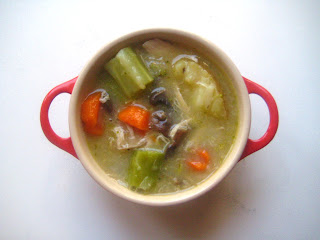Miso Soup with Pork Spare Ribs:

First, our vegetables: 1/2 head of Napa Cabbage, 3 stalks of green onions (scallions, if you will), and 1 block of medium firm tofu.

For the meat, here I'm using about 2 lbs of pork spare ribs, cut into 1in. pieces. (Ask your butcher to do that) I like them because they do make for a nice pork broth to serve as the base for the miso, but you can use any meat you'd like here, such as chicken breast. If you're using a boneless meat, just go with 1lb. Or you can skip the meat altogether if there are vegetarians abound.

Slice the napa cabbage into 1 inch wide strips, the tofu into 1/2 in cubes, and the scallions into 1in. pieces on the bias. This makes for a more stew like miso soup, with substantial enough ingredients to stand as meal on its own.
For a lighter version, skip the cabbage altogether, cut the tofu into 1/4 in. cubes ,and the scallions into small 1/4 in. pieces. Then you'll get miso soup that's more akin the starter that you get at Japanese restaurants.

So in a large pot or wok, bring around 8 to 10 cups of water to a boil, depending on how much water your pot can hold (keep in mind all the other ingredients that'll go in later).

Start with the spare ribs, and let the water come to a boil again. Around 5 minutes or so.

Then all at once, add your cabbage, tofu and scallions, and cover.

When that comes to a simmer, add one whole cap-ful of dashi (around 2 tablespoons). If you're making a vegetarian version, keep in mind dashi is made from fish~

Cover and let simmer on medium high for about 5 more minutes. You want to cook the ribs until they really start to pull away from the bone and the meat can be pulled apart quite easily.

You can see how much the ingredients have shrunk after a while. Also, depending on the spare ribs you get, they can give off a lot of fat. So at this stage, I like to skim off some of the oil that comes to the surface.

And now we add our miso. There are quite literally 8 million manufacturers of miso in the world, but really only 2 main varieties: red ("akamiso") and white ("shiromiso"). As far as taste goes, more often than not, red has a deeper flavor than white, but again, that also depends on the manufacturer.
So when it comes to what varieties taste like what, it's really all up in the air. Most American supermarkets will have a very limited selection of miso to begin with. For example, this brand of miso was all I could find at Whole Foods.
Go to Japanese market however, and you'll find an entire shelf filled with nothing but miso. At the point, just grab whatever, and see how you like it.

For a large volume of soup like this, you'll need about 3 or 4 heaping tablespoons of miso. Turn the heat down to medium, and spoon the miso (one tablespoon at a time) into onto your ladle.

And with another small spoon, OR CHOPSTICKS, break up the miso in the ladle until it dissolves completely. Miso doesn't dissolve that well by itself if you just lump it into the pot.

It's important to wait until the very end to add the miso, and on low to medium heat. Boiling miso will actually kill the flavor. So be sure to turn the heat down to medium to medium low before you add the miso.
Also, flavor to your liking here. 3 heaping tablespoons is for this particular brand of miso. Have taste before you add another tablespoon. You might need more or less depending~

And alas~ You have a nice hearty Japanese soup. You can add udon or ramen to make this a full meal.




SO, your ingredient list:
Miso Soup with Pork Spare Ribs
- 1/2 head of napa cabbage
- 3 stalks of green onions (scallions)
- 1 block of medium firm tofu
- 2 lbs of pork spare ribs
- 8-10 cups of water
- 2 tablespoons dashi
- 3 large tablespoons of miso





























































